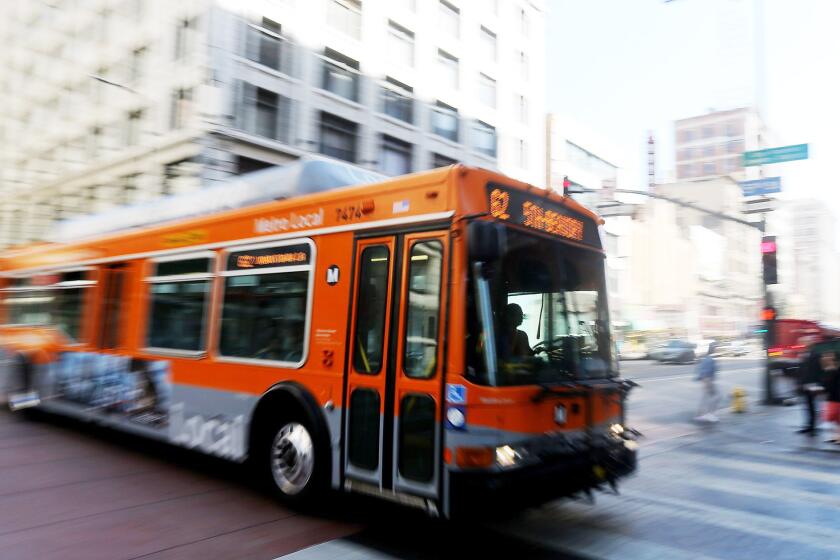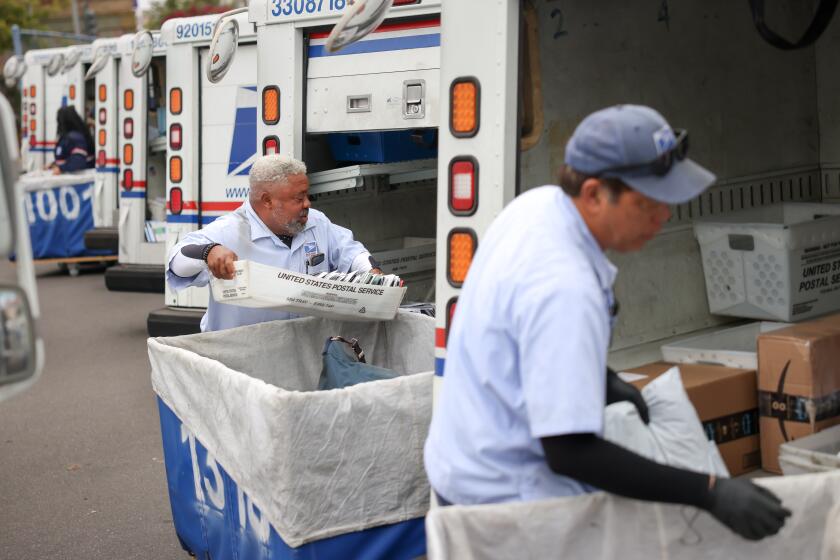Monorail Buff Has a 1-Track Mind
- Share via
The thought first came to Chuck Dozer as he relaxed after a particularly hair-raising freeway commute back to his student digs at Whittier College.
His idea: A transit system closely resembling Disneyland’s monorail but more flexible; a system that could soar over crowded freeways and through tall buildings. It would travel on rubber-tired wheels along special-surface tracks and and lure the most dyed-in-the-wool California motorist out of his car for the trip between home and office without a single red traffic signal or screech of the brakes.
That was two decades ago and Dozer, now a San Diego financial consultant, has little to show for his brainstorm except a dozen letters of encouragement, a U.S. patent and a traffic-jam sizehone bill to Washington.
Still he persists in bending
the ears of transit officials, politicians, private developers and anyone else with the time or the interest to listen to his idea for a cheap, flexible, efficient, non-polluting, quiet, modern method for getting commuters out of their cars and off the freeways.
No one has come up with a method of financing a pilot project to demonstrate the feasibility of his project. Since he obtained a patent for his idea 2 1/2 years ago, Dozer has knocked on many doors without making a sale.
Still, he hasn’t lost his enthusiasm.
And now, finally, someone seems to be listening. Strangely enough, it’s not a huge, traffic-clogged metropolitan area, but a small North County city with a big traffic future. If Dozer’s idea gets a chance, it may be the City of San Marcos that offers it. At least city officials are intrigued by it.
Some San Diego-area officials remember when ideas like Dozer’s would have been snapped up for testing. George Franck, senior transportation planner for the San Diego Assn. of Governments, harking back to the days when everyone was vying for “state of the art” systems on the “cutting edge” of technology. Back then, Dozer would have been wooed by a dozen think-tank organizations and as many governmental agencies, Franck said.
Then the Bay Area Rapid Transit (BART) came along in the San Francisco area and those agencies spending public funds pulled in their horns and began to opt for proven transit systems that couldn’t be paralyzed by a glitch in an electronic system. Driverless vehicles, such as the ones designed for BART, gave way to trolleys. Designers turned from designing new systems to modernizing existing ones, Franck said.
James Mills, former state senator and present chairman of the Metropolitan Transit Development Board, admits that the MTDB, as operator of the financially-successful San Diego Trolley system, is not about to become involved in advancing front money for an untested project such as the one Dozer is proposing.
In fact, Mills said, there is a proviso in legislation he sponsored that created the transit agency restricting it from using anything but “off-the-shelf” technology--equipment already tested and ready to go.
The BART experience was the incentive for Mills’ embargo against technology that has not yet been proven. “They didn’t have the ability to operate it then and they don’t have the bugs out of it yet,” he said.
Swiss engineers have been granted a contract to construct a monorail in Sydney, Australia, and a French firm has contracted to build one in Japan. Japanese and German engineers are tinkering with magnetic levitation as a means of transit propulsion. But the United States is sticking with proven technology.
Except, possibly, in San Marcos. The North County community, population 23,248, is about to explode into a city of 50,000 in the next decade or so and needs a solution to its traffic problems.
San Marcos Mayor Lee Thibadeau has taken Dozer’s idea very seriously and proposes it as a solution for the coming of a major commercial-industrial-residential development around a satellite campus of San Diego State University.
“This is an exciting concept which might just fit in with our town,” Thibadeau said. “We possibly may get private money involved in this.”
Thibadeau sketched a verbal picture of the future town center/university-campus-area transit system as “crossing over Highway 78 and going through the third floor of a five-story building, then over to the campus library,” with stops along the way.
He sees Dozer’s monorail system as a way to bridge the gap between a proposed Oceanside-to-Escondido commuter rail line north of California 78 and the campus-town center south of the highway.
“I’m thinking Palomar (College), San Diego State, the town center and east to Escondido,” Thibadeau said.
He envisions private industry tying into the line, perhaps extending it to North County Fair shopping center, south to Rancho Bernardo’s industrial park, and onwards.
Steve Bieri, project manager for the proposed San Marcos town center, also warmed to the idea of a flexible transit system that could spiral through the 1,000-acre area, stopping at convenient locations that would not require half-mile treks for shoppers, workers or residents.
“I don’t know the details of his system, but it sounds pretty spiffy to me,” Bieri said.
Dozer describes his transit proposal as a tilt-rail transit vehicle--a tubular vehicle carrying 24 to 30 persons, but “not a cattle car packing people in”--that could travel on an electric rail, above or on ground level as the terrain and traffic dictates.
“Flexibility” is the factor that places Dozer’s system ahead of current fixed-rail systems, he says.
Jerry Backoff, San Marcos planning director, calls the idea of a monorail “intriguing” because it would solve the conundrum of how to move people from the planned North County Transit District commuter line north of overcrowded California 78 into the proposed Town Center and satellite SDSU campus without clogging already congested surface streets. The town center--located on a former chicken ranch--is scheduled to get under way in a couple of years, and the SDSU campus is expected to be operating by 1992.
NCTB officials have some reservations on the avant-garde tilt-rail system, especially the ability to move people from one system--conventional rail--to another--monorail.
Thibadeau, however, looks at the bright side of Dozer’s bright idea.
“Can’t you visualize a transit system that can connect into the existing systems and can spiral off for a stop at the Carlsbad mall,” he said. “Close your eyes and imagine a conveyor belt that will deliver you where you want to go without disrupting auto traffic.
“I think it is an exciting concept. It will be a lot cheaper to do it now than 20 years down the road, and if we don’t do it, we’ll be like Los Angeles, double-decking freeways and building expensive tunnels. I think that it’s time to try something new.”
More to Read
Sign up for Essential California
The most important California stories and recommendations in your inbox every morning.
You may occasionally receive promotional content from the Los Angeles Times.










